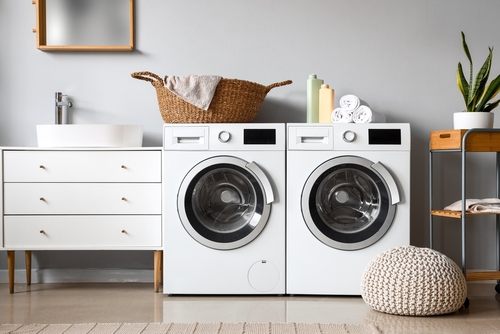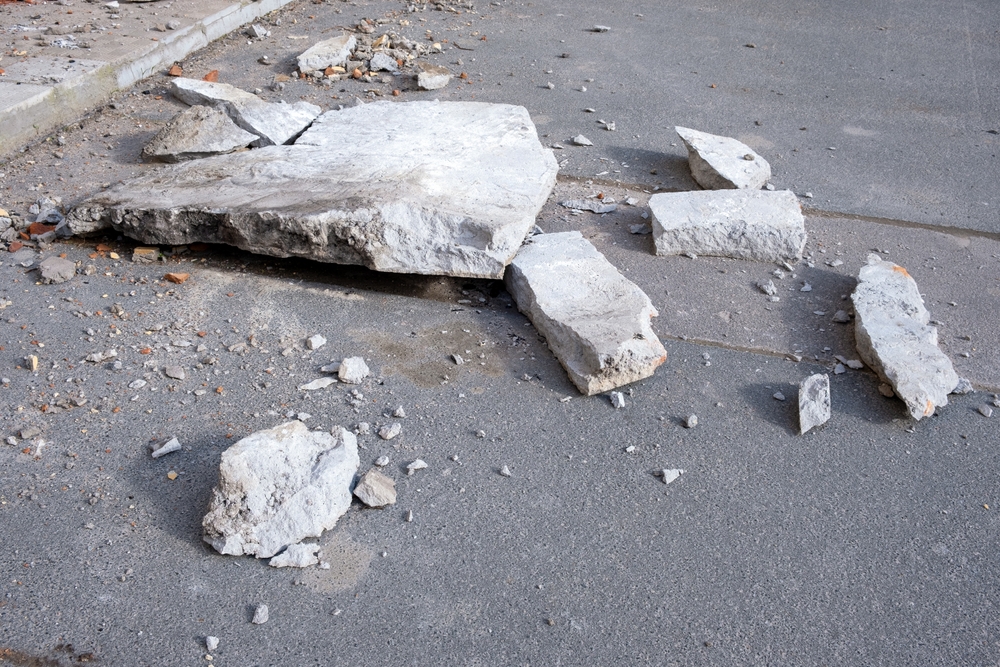April 11, 2024 - Benjamin Ehinger
How to Dispose of a Washer and Dryer: Safe and Eco-friendly Methods
CALL NOW 844-762-8449
Disposing of old appliances like washers and dryers can sometimes seem daunting. However, it’s important to handle this task properly to reduce environmental impact and possibly even benefit from the disposal process. Your washing machine and dryer have served you well, but when they reach the end of their life cycle, knowing the right steps to take can help you manage disposal efficiently and responsibly.
There are multiple options for disposing of your appliances. You can choose to recycle, which ensures that valuable materials are recovered and harmful substances are handled correctly. Alternatively, donating your working appliances can extend their life and assist those in need. If your washer and dryer aren’t in working condition, consider selling for parts or scrapping for metal. With a bit of research, you will find a disposal option that aligns with your priorities, whether they’re practical, financial, or environmental.
 When you’re ready to upgrade your laundry appliances, your disposal choices can have significant environmental implications. Ensuring your old washer and dryer are handled in an eco-friendly way can minimize electronic waste (e-waste), reduce your carbon footprint, and contribute to sustainability efforts.
When you’re ready to upgrade your laundry appliances, your disposal choices can have significant environmental implications. Ensuring your old washer and dryer are handled in an eco-friendly way can minimize electronic waste (e-waste), reduce your carbon footprint, and contribute to sustainability efforts.
 When your washing machine or dryer reaches the end of its life, you have options that can benefit you financially. The growing second-hand market for appliances offers a way to recoup some of the value from your used machines. Here, we’ll specifically explore selling your appliances through online marketplaces and trading them in via retailer programs.
When your washing machine or dryer reaches the end of its life, you have options that can benefit you financially. The growing second-hand market for appliances offers a way to recoup some of the value from your used machines. Here, we’ll specifically explore selling your appliances through online marketplaces and trading them in via retailer programs.
Key Takeaways
- Proper disposal of washers and dryers is essential for environmental conservation.
- Exploring recycling or donation options can have positive social and ecological impacts.
- Selling or trading old appliances can be beneficial for financial or practical reasons.
Preparing for Disposal
Before you can dispose of your washer or dryer, it’s important to assess their condition, remove non-disposal items, and select the most suitable method for disposal. This proactive approach ensures safety, maximizes potential scrap value, and considers environmental impact.Assessing the Condition
Determine whether your dryer or washing machine is still in working order or has energy efficiency that could be valuable to someone else. If they’re operational or repairable, they might be better suited for donation rather than recycling. For appliances that are past their prime, note which metal parts or valuable components could be removed for scrap value.Removing Non-Disposal Items
Carefully inspect and remove any items that are not meant to be disposed of or recycled. This typically includes:- Hoses and water leaks checks
- Electrical cords or plugs
- Any personal items left in the cavities
Selecting a Disposal Method
Choose a disposal method that aligns with the condition of your appliances and local regulations:- Donation: If still functional
- Recycling: For reclaiming metal parts and components
- Junk removal services: For convenience or you can get a home dumpster rental
- Sell for scrap: To earn money from valuable components
Disposal Options
Disposing of an old washer and dryer involves several options, from environmentally-friendly recycling programs to donation opportunities. You’ll need to assess which option aligns with your disposal preferences and the condition of your appliances.Recycling Programs
Your local government or recycling centers may offer programs to take in large appliances like washers and dryers. These facilities dismantle the units to salvage metal and dispose of the rest in an environmentally responsible way. Before dropping off your appliances, ensure the center accepts them and inquire if there is any fee.Junk Removal Services
Engaging professional junk removal services is convenient for hauling away your old appliances. They often commit to recycling and re-purposing the items they collect, reducing environmental impact. You can find services that may offer to pick up your washer and dryer for a fee.Donation and Non-Profit Organizations
If your washer and dryer are still in working condition, consider donating them to non-profits such as Habitat for Humanity’s ReStore or The Salvation Army. These organizations typically accept appliances and either provide them to those in need or sell them to fund charitable endeavors. Always confirm donation guidelines in advance.Retailer and Manufacturer Initiatives
Some appliance retailers and manufacturers offer take-back programs when you purchase a new machine. This option is not only convenient but also ensures that your old appliances are disposed of correctly. Check if the retailer or manufacturer runs a manufacturer’s recycling program, and ask about any associated costs or conditions. Remember to check each option for specific requirements and whether there is any cost involved.Environmental Considerations
 When you’re ready to upgrade your laundry appliances, your disposal choices can have significant environmental implications. Ensuring your old washer and dryer are handled in an eco-friendly way can minimize electronic waste (e-waste), reduce your carbon footprint, and contribute to sustainability efforts.
When you’re ready to upgrade your laundry appliances, your disposal choices can have significant environmental implications. Ensuring your old washer and dryer are handled in an eco-friendly way can minimize electronic waste (e-waste), reduce your carbon footprint, and contribute to sustainability efforts.
E-Waste Recycling Centers
E-waste recycling is a crucial step in mitigating the adverse environmental impacts of discarded electronics. Recycling centers specializing in appliances play a vital role by disassembling the units and responsibly managing valuable and potentially hazardous materials. For instance, metals such as copper and aluminum within your appliances can be recovered and reused. To locate your nearest e-waste recycling center, you may refer to resources provided by the Environmental Protection Agency (EPA), which encourage eco-friendly practices.- Find a Recycling Center:
- Visit the EPA website for certified facilities.
- Check municipal or local government resources.
Responsible Disposal and Sustainability
Disposing of your appliances in a responsible manner is key to promoting sustainability. Instead of sending your old washer and dryer to already overflowing landfills, consider options like donation or selling for parts, where they can be refurbished and re-purposed. These actions help reduce the demand for new resources and the energy consumption associated with manufacturing new appliances, thus decreasing the overall environmental impact.- Sustainability Tips:
- Donate to charity or give away for reuse if appliances are functional.
- Sell or give to e-waste recyclers for parts if no longer operational.
Practical Information
When you’re ready to part ways with your old washer and dryer, several disposal options are available to you. It’s important to handle your disposal responsibly to minimize environmental impact and possibly benefit financially or through convenience.Local Collection Programs
Some utility companies and local governments offer bulk pickup services, which can sometimes include large appliances. Check your local government’s website or call their office to find out if they run such a program. If available, this service might be free or have a nominal fee, making it a hassle-free option.Understanding Scrap Yard Processes
You can turn your unwanted appliances into cash by contacting local scrap yards or scrap metal recyclers. These facilities often accept washers and dryers, breaking them down and recycling their valuable metal components. Before hauling your machines there, call ahead to understand the materials they accept and their payout rates, as these can vary.Navigating Retailer Take-Back Programs
Retailers like Home Depot and Best Buy sometimes offer take-back programs, especially if you’re purchasing new, energy-efficient appliances from them. Costco may also provide similar services. Often, these programs might involve the retailer collecting your old appliance upon delivery of the new one. Contact the stores directly for specifics regarding any disposal services they offer. Remember, if none of these options fit your situation, services can remove and dispose of your appliances for you. Although there is a fee, they can save you time and effort, especially if you do not have the means to transport the appliances yourself. Should you have multiple items to dispose of or are undertaking a large home cleanout, you might consider the option to rent a local dumpster as a cost-effective waste management solution.Selling and Trading
 When your washing machine or dryer reaches the end of its life, you have options that can benefit you financially. The growing second-hand market for appliances offers a way to recoup some of the value from your used machines. Here, we’ll specifically explore selling your appliances through online marketplaces and trading them in via retailer programs.
When your washing machine or dryer reaches the end of its life, you have options that can benefit you financially. The growing second-hand market for appliances offers a way to recoup some of the value from your used machines. Here, we’ll specifically explore selling your appliances through online marketplaces and trading them in via retailer programs.
Online Marketplaces
You can list your washer and dryer on various online platforms where potential buyers frequently search for used appliances. Facebook Marketplace and Craigslist are popular options that allow you to reach a large audience with no listing fees. When selling on these platforms:- Photograph: Take clear, high-quality pictures of your appliances.
- Describe: Provide detailed descriptions, including any smart features, age, and condition.
- Set a Price: Determine a fair asking price by researching what similar models are selling for.
- Communicate: Respond promptly to inquiries and be upfront about any issues.
Trade-In Programs
Some retailers offer trade-in programs that can be an effortless way to transition from your old appliances to new ones. Best Buy and Home Depot may have options for taking your used machines off your hands in exchange for a discount on your next purchase. To engage in a trade-in program:- Inquire: Contact the retailer to ascertain if they have a trade-in program and the terms associated with it.
- Evaluate: Consider the trade-in value against the potential sale value in the market.
- Decide: If the convenience and immediate savings outweigh the effort of selling, trading in could be your best option.
Frequently Asked Questions
When considering how to dispose of your washer and dryer, it’s important to know what disposal and recycling options are available, potential costs, and local services that could assist in the process.Who offers free appliance removal services?
Some retailers offer free removal services for appliances when you purchase a new one. Check with your retailer for such programs.What are the options for recycling a washing machine and dryer?
You can recycle your old appliances through local recyclers, donation centers, or scrap metal services, ensuring they are responsibly handled.Can I receive cash for recycling a washer and dryer?
Yes, by taking your washer and dryer to a scrap metal recycler, you may receive cash depending on the scrap metal value, but consider any associated costs, such as transportation.Are there any specific disposal services for appliances offered by local municipalities?
Local waste management divisions often have programs for heavy trash pick-up and recycling of appliances. Contact your local division for more details.What should I consider when choosing a disposal service for my home appliances?
Evaluate the disposal service’s convenience, cost, environmental impact, and any potential financial return you might receive from recycling your old appliances.How can I find appliance disposal options in my vicinity?
Refer to resources like ENERGY STAR or local government websites to identify authorized disposal programs and recycling options that might exist in your area for appliance disposal.RECENT BLOGS
Our Reviews
Glenda Lanier Prowell
1721758635
I have ordered an 11 yard dumpster to be delivered to my house.Lonier was extremely helpful and answered all my questions. The rate was very reasonable.
Cedric Smikle
1721660395
Amber was extremely professional and courteous. She answered all of my questions and even some that I didn’t know I needed to ask.
Cait Kaider
1721243051
I highly recommend Waste Removal USA for their responsiveness and how the staff work hard to provide exceptional customer service. They have done well by us and our clients. Thank you!
Easom Family
1721223306
Louiner Pierre-Louis Is awesome! Did a great job. Will definitely be using this same company for all my dumpster needs because of his awesome customer service! Thank you!!!
tabitha Vazquez
1720539988
Wonderful and fast customer service!
LATEST BLOGS






